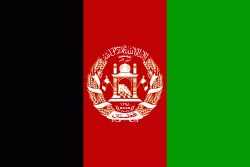Bamiyan (Bāmyān)
Bamyan or Bamyan Valley ; also spelled Bamiyan or Bamian is the capital of Bamyan Province in central Afghanistan. Its population of approximately 70,000 people makes it the largest city in Hazarajat. Bamyan is at an altitude of about 8366 ft above sea level. The Bamyan Airport is located in the middle of the city. The driving distance between Bamyan and Kabul in the southeast is approximately 180 km. The Band-e-Amir National Park is to the west, about a half-hour drive from the city of Bamyan.
Bamyan is referred to by some as the "Shining Light" and "Valley of Gods". There are several tourist attractions near the city, including the Buddhas of Bamyan, which were carved into cliffs on the north side of Bamyan city in the 6th and 7th century CE, dating them to the Hephthalite rule. Other attractions close to the city include Shahr-e Gholghola and Zuhak. In 2008, Bamyan was found to be the home of the world's oldest oil paintings. At the end of the 10th century, there was a Buddhist culture in which several thousand Buddhist monks lived in caves carved into the mountain. The 53 meters known as the Salsal and 35 meters known as Shahmama are the high-standing Buddha statues and best-known monuments left by the Buddhists, which were destroyed by the Taliban in 2001. Furthermore, there are several cultural sites left from both the Buddhist and the later Islamic era of the valley. After the overthrown of the Taliban from power in 2002, considerable efforts had been made to preserve the cultural monuments in the valley. The city of Bamyan has four districts and a total land area of 3,539 hectares. The total number of dwellings in this city is 4,435.
The Bamyan valley marked the most westerly point of Buddhist expansion and was a crucial hub of trade for much of the second millennium CE. It was a place where East met West and its archaeology reveals a blend of Greek, Turkic, Persian, Chinese, and Indian influences. The valley is one of Afghanistan's most touristic places.
The city of Bamyan joined the UNESCO Creative Cities Network as a Crafts and Folk Art city in 2017. "UNESCO noted the Bamiyan Valley is the most monumental expression of western Buddhism". Bamiyan is now listed by UNESCO as a World Heritage Site in Danger.
On 15 August 2021, Bamyan was seized again by Taliban fighters, becoming the twenty-ninth provincial capital to be captured by the Taliban as part of the wider 2021 Taliban offensive.
The name "Bamiyan" is derived from Middle Persian Bamikan.
Bamyan is referred to by some as the "Shining Light" and "Valley of Gods". There are several tourist attractions near the city, including the Buddhas of Bamyan, which were carved into cliffs on the north side of Bamyan city in the 6th and 7th century CE, dating them to the Hephthalite rule. Other attractions close to the city include Shahr-e Gholghola and Zuhak. In 2008, Bamyan was found to be the home of the world's oldest oil paintings. At the end of the 10th century, there was a Buddhist culture in which several thousand Buddhist monks lived in caves carved into the mountain. The 53 meters known as the Salsal and 35 meters known as Shahmama are the high-standing Buddha statues and best-known monuments left by the Buddhists, which were destroyed by the Taliban in 2001. Furthermore, there are several cultural sites left from both the Buddhist and the later Islamic era of the valley. After the overthrown of the Taliban from power in 2002, considerable efforts had been made to preserve the cultural monuments in the valley. The city of Bamyan has four districts and a total land area of 3,539 hectares. The total number of dwellings in this city is 4,435.
The Bamyan valley marked the most westerly point of Buddhist expansion and was a crucial hub of trade for much of the second millennium CE. It was a place where East met West and its archaeology reveals a blend of Greek, Turkic, Persian, Chinese, and Indian influences. The valley is one of Afghanistan's most touristic places.
The city of Bamyan joined the UNESCO Creative Cities Network as a Crafts and Folk Art city in 2017. "UNESCO noted the Bamiyan Valley is the most monumental expression of western Buddhism". Bamiyan is now listed by UNESCO as a World Heritage Site in Danger.
On 15 August 2021, Bamyan was seized again by Taliban fighters, becoming the twenty-ninth provincial capital to be captured by the Taliban as part of the wider 2021 Taliban offensive.
The name "Bamiyan" is derived from Middle Persian Bamikan.
Map - Bamiyan (Bāmyān)
Map
Country - Afghanistan
 |
 |
| Flag of Afghanistan | |
Human habitation in Afghanistan dates back to the Middle Paleolithic era, and the country's strategic location along the historic Silk Road has led it to being described, picturesquely, as the ‘roundabout of the ancient world’. Popularly referred to as the graveyard of empires, the land has historically been home to various peoples and has witnessed numerous military campaigns, including those by the Persians, Alexander the Great, the Maurya Empire, Arab Muslims, the Mongols, the British, the Soviet Union, and most recently by a US-led coalition. Afghanistan also served as the source from which the Greco-Bactrians and the Mughals, amongst others, rose to form major empires. The various conquests and periods in both the Iranian and Indian cultural spheres made the area a center for Zoroastrianism, Buddhism, Hinduism, and later Islam throughout history.
Currency / Language
| ISO | Currency | Symbol | Significant figures |
|---|---|---|---|
| AFN | Afghan afghani | Ø‹ | 2 |
| ISO | Language |
|---|---|
| PS | Pashto language |
| FA | Persian language |
| TK | Turkmen language |
| UZ | Uzbek language |















